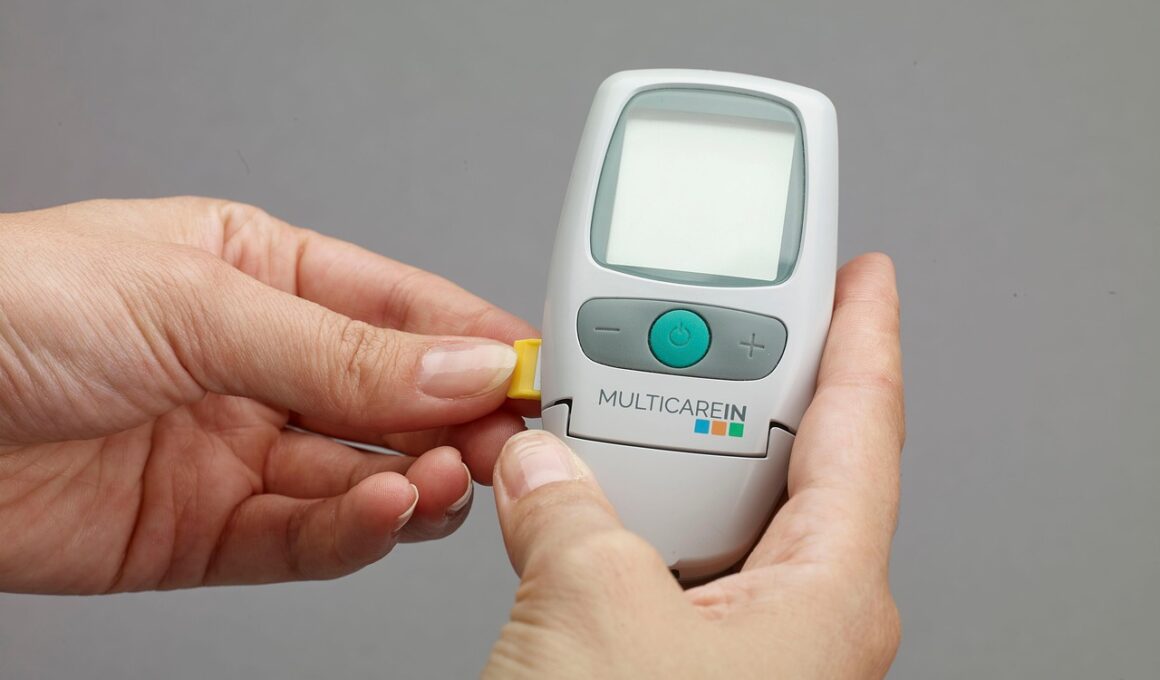Monitoring Your Diabetic Dog for Emergency Symptoms
Keeping your diabetic dog healthy requires vigilance and knowledge. Dogs with diabetes may experience emergencies, requiring immediate attention. Regular monitoring for symptoms of dangerously low or high blood sugar levels is essential. Symptoms of low blood sugar, or hypoglycemia, can include weakness, confusion, loss of coordination, or seizures. Conversely, high blood sugar, or hyperglycemia, can manifest as increased thirst, excessive urination, or lethargy. As a responsible pet owner, you should regularly check your dog’s glucose levels to prevent emergencies. Understanding these symptoms will allow you to act quickly, potentially saving your dog’s life. Additionally, keeping a close eye on their behavior can help you detect fluctuations in their condition that warrant concern. If you notice any unusual behavior or symptoms, contact your veterinarian immediately for advice. Developing a strong relationship with your vet by regularly discussing your dog’s diabetes management plan and adjusting it when necessary will also benefit your canine companion’s well-being. Note that having emergency contacts on hand helps when things take a sudden turn for the worse.
Monitoring your diabetic dog’s diet is another crucial aspect to consider. A balanced diet tailored to their specific needs can help stabilize their sugar levels. Work with your veterinarian to understand what your dog should eat and when. Consistent feeding times can significantly help regulate their blood sugar. Proper nutrition will also help manage weight, reducing any complications related to diabetes. Be sure to educate yourself about the ingredients in dog food. Look for quality, high-fiber, and low-fat options that meet your dog’s requirements. Avoid feeding your dog human food, as it can lead to fluctuations in glucose levels. Moreover, regular exercise plays a vital role in controlling diabetes. Daily walks or playtime can help utilize excess glucose and maintain a healthy weight. However, consult your vet regarding the best exercise regimen for your dog to ensure it doesn’t lead to hypoglycemia. Monitoring at-home glucose levels can provide insight into your dog’s daily health and safety. Make use of glucose meters to regularly assess their blood sugar.
Identifying Signs of Hypoglycemia
Recognizing the warning signs of hypoglycemia can be life-saving. If your diabetic dog exhibits sudden weakness or appears dazed, immediate intervention may be necessary. Notice any unusual behavior, such as trembling or whining, could indicate a drop in blood sugar levels. If these symptoms occur, act quickly. You can provide a quick source of glucose, such as corn syrup or honey applied to the gums. This rapid sugar source can temporarily elevate levels, but immediate veterinary care is recommended. Look for unsteady walking or coordination loss. Behavioral changes, such as confusion or aggression, may also be visible in dogs experiencing hypoglycemia. Regularly practice monitoring your dog’s glucose levels, especially after a dose of insulin or a change in meal schedules. Observing these symptoms enables earlier interventions and better outcomes for your beloved pooch. Additionally, maintain emergency supplies of glucose sources at home and while traveling. Knowledge and preparation are essential tools in managing your diabetic dog’s health and ensuring their happiness.
In contrast, be aware of the signs of hyperglycemia, as these symptoms can also pose a threat. Elevated blood sugar levels can arise from missed insulin doses, dietary shifts, or illness. Look for key signs like increased thirst, frequent urination, and lethargy. A diabetic dog might also experience sweet-smelling breath or develop recurrent infections. These signs should give you an opportunity to act proactively. Monitoring your dog’s glucose levels closely will help you track any unusual fluctuations. If hyperglycemia remains untreated, it may lead to serious complications, like ketoacidosis. Therefore, a consistent routine with food, insulin, and exercise will mitigate these risks. Educating yourself about both hypo and hyperglycemia ensures you are prepared to manage emergencies in diabetic dogs effectively. Bear in mind, if you suspect your dog’s sugar levels are too high, contact your veterinarian immediately for further instruction. Do not attempt to adjust insulin doses without professional guidance. Always prioritize your dog’s health and keep a close watch on their glucose levels regularly.
Emergency Preparedness and First Aid
Being prepared for emergencies involves learning essential first aid techniques for your diabetic dog. Familiarize yourself with the steps to take when symptoms arise, enabling you to act swiftly. Create a dog first aid kit that includes glucose gel, syringes, and a glucose monitor. This kit should be easily accessible in your home and while traveling. When providing first aid, remember to remain calm to avoid stressing your dog further. Assess the severity of their condition and follow appropriate protocols for either hyperglycemia or hypoglycemia. If your dog loses consciousness or experiences seizures, seek immediate veterinary assistance. Contact your veterinarian or an emergency animal clinic for guidance during critical situations. Document your dog’s condition, any treatments you’ve administered, and any symptoms you have observed for the veterinarian. This information can assist in their diagnosis and care. Additionally, consider enrolling in canine first aid courses, giving you valuable skills and knowledge. Preparing yourself and having supplies at hand fosters confidence in managing your diabetic dog’s health effectively.
Don’t underestimate the importance of regular veterinary check-ups for your diabetic dog. Routine visits can help your veterinarian monitor your pet’s overall health and diabetes management effectively. During these appointments, your vet will conduct necessary tests to assess your dog’s glucose levels and adjust insulin dosages if required. They may also evaluate your dog’s weight to ensure they are on target. These visits are beneficial for discussing any new concerns you may have observed in your dog. Regular testing can prevent complications and enable early detection of potential health issues linked to diabetes. Moreover, developing a health log documenting your dog’s behavior, eating habits, and glucose levels can provide valuable insights during yearly examinations. Keep your vet informed about any changes in your dog’s behavior or symptoms. This proactive approach builds a strong relationship with your veterinary team, ultimately benefiting your diabetic dog’s quality of life. Utilize all the resources available to educate yourself about canine diabetes and the necessary care and emergency procedures involved.
Conclusion: A Healthy, Happy Diabetic Dog
In summary, regular monitoring of your diabetic dog’s health is paramount to preventing emergencies. By understanding symptoms of both hypoglycemia and hyperglycemia, you will be equipped to act quickly. This vigilance, coupled with a well-structured diet, regular exercise, and veterinary check-ups, lays the groundwork for a healthy lifestyle. Immediate preparedness for emergencies ensures your pet gets the right care quickly during crises. Empower yourself with the knowledge of first aid techniques and have the necessary supplies ready. Building a solid relationship with your veterinarian fosters better management of your dog’s diabetes, enhancing their well-being. Your dedication to learning about and caring for your diabetic dog will promote their happiness and longevity. Remember to remain patient and observant as your furry friend navigates through life with diabetes. With your attention and care, they can lead a fulfilling life. By monitoring for symptoms, adjusting their routine, and seeking veterinary assistance as needed, you remain the advocate your beloved dog requires. Always prioritize their health and happiness.



